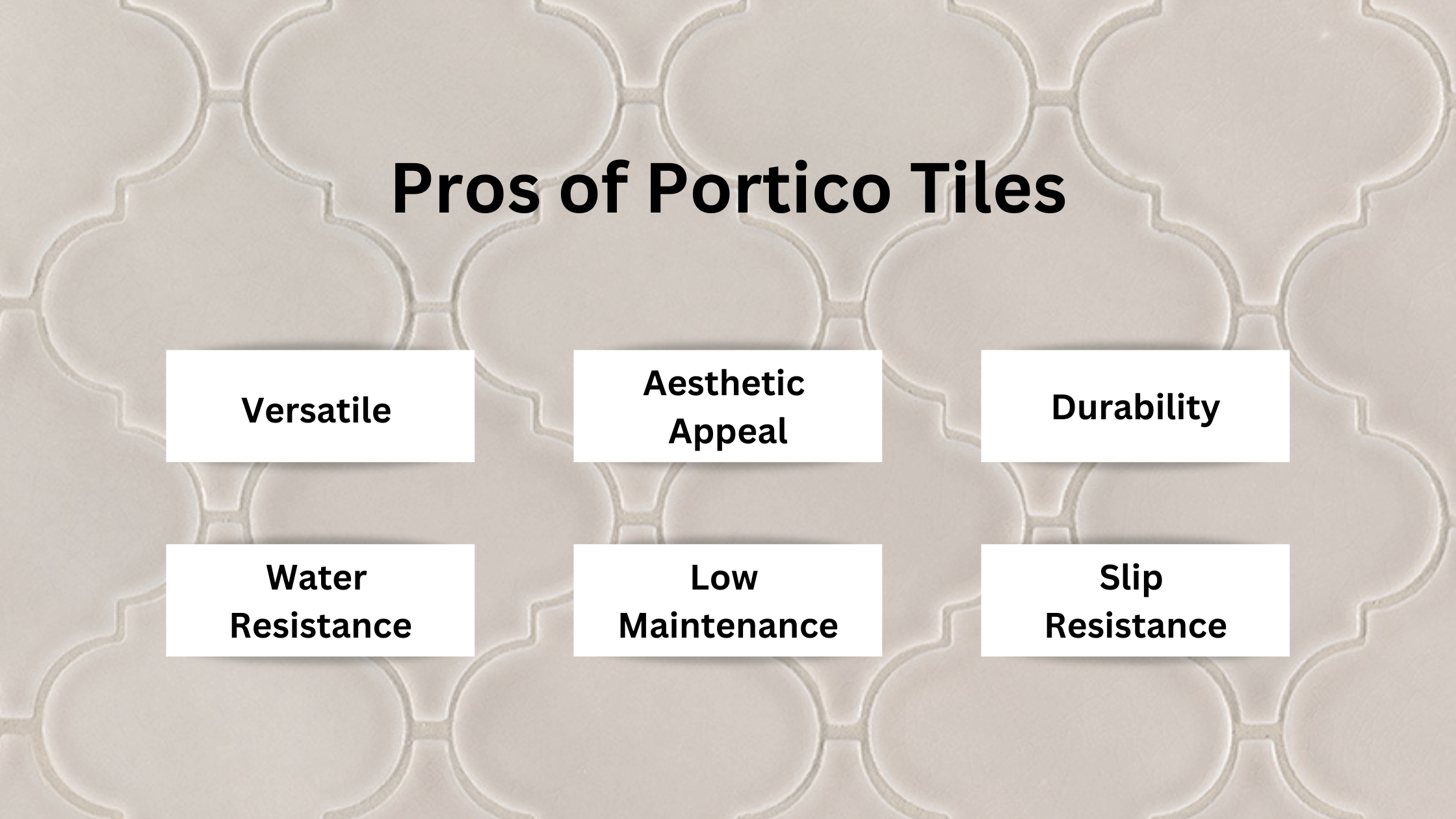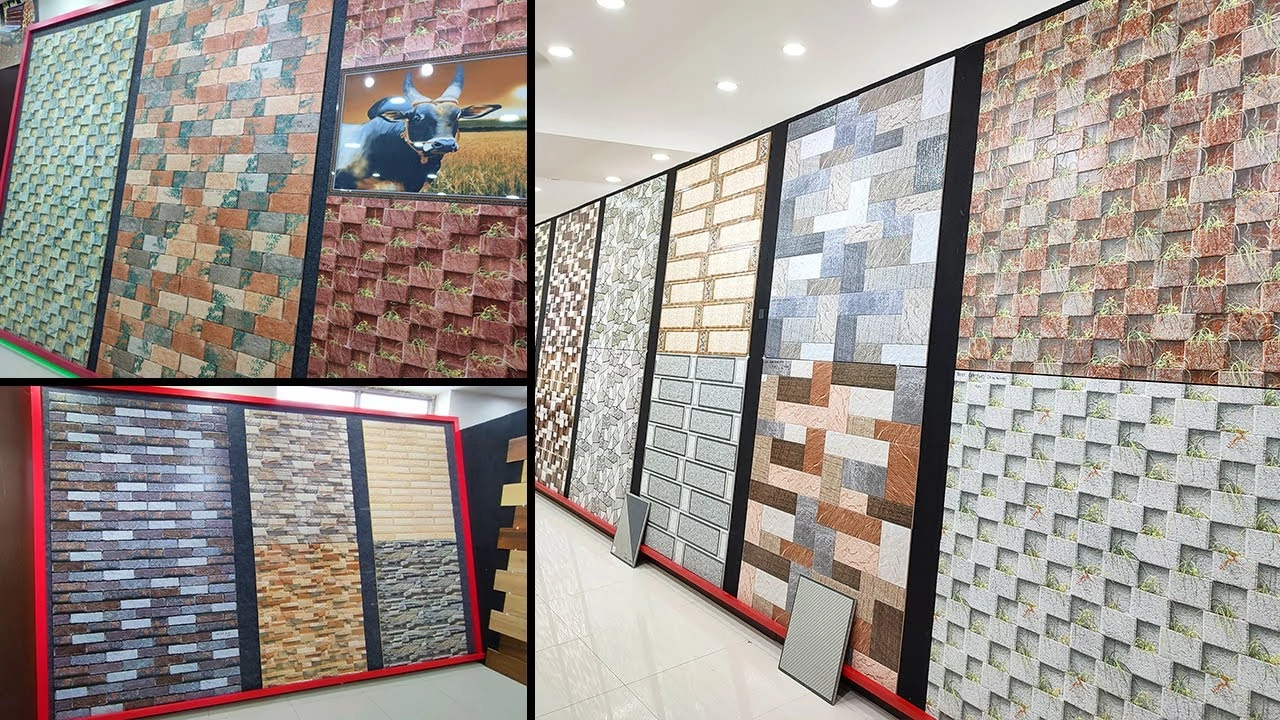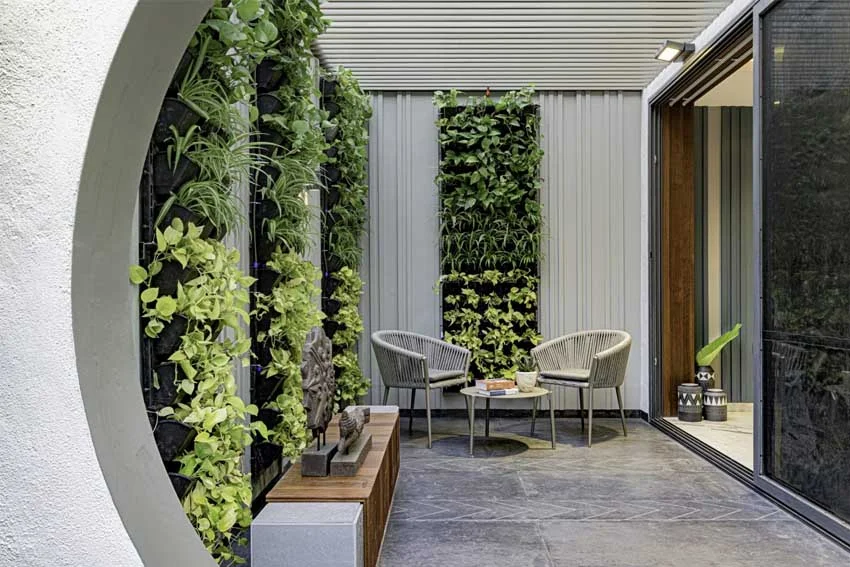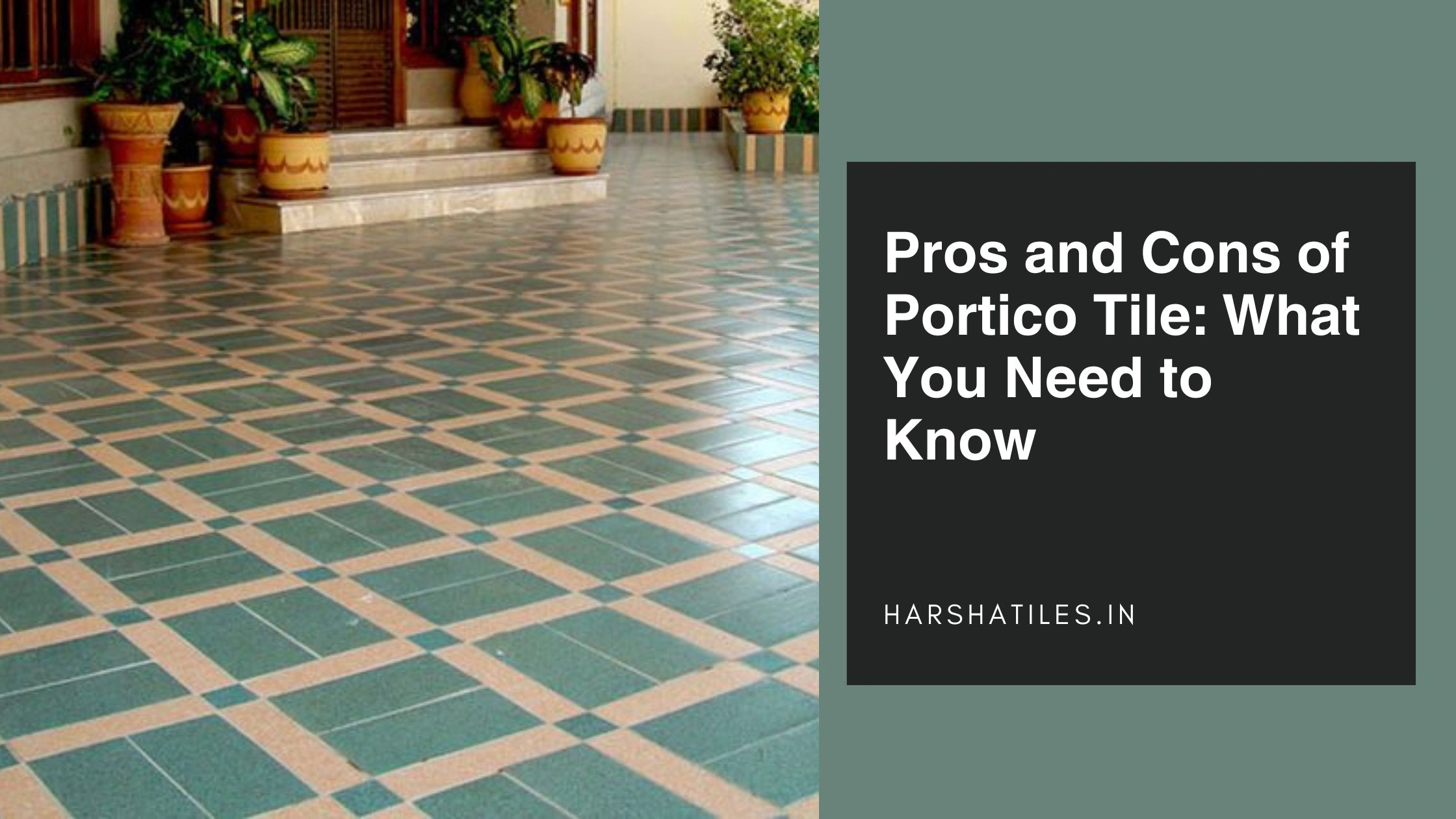Oct 03, 2025
Connect With Our Team
Pros and Cons of Portico Tile: What You Need to Know
- Home
- Utilities
- News & Blog
When selecting tiles for home entrance areas, the choice is quite crucial as it really sets the welcome tone to visitors and provides much boosting curb appeal. Among the tiles, portico tiles were designed strictly for entrance areas, offering a mix of style, durability, and functionality. Be it a modern minimalist look or a classically traditional style, portico tiles would work wonders for a house's entryway. In this article, let's discuss the benefits and drawbacks of portico tiles to help you make an informed choice.
What Are Portico Tiles?
Portico tiles are special tiles used in entrance areas, such as a porch, patio, and verandas. Not only do they serve the purpose of functionality, but there is also an aesthetic purpose in making the entrance of one's home warm and pleasing to the eye. Thus, portico tiles have been designed to be strong and durable, with low maintenance but might change style to suit different home designs, highly conducting high traffic as well as shifting weather conditions.
Pros of Portico Tiles

Aesthetic Appeal
Portico tiles have various colors, textures, and patterns. You can have an excellent front door entrance that will really match well with the whole design of the house. Its beauty can really beautify curb appeal and create a mood for what you can expect to be inside your place.
Material Variety
Portico tiles are offered in a number of materials and provides their own set of advantages; the most popular ones include the ones made from ceramics, which are quite versatile as well as cost-efficient, porcelain tiles that provide durability together with water resistance, and natural stone made from granite or limestone, which offer that full luxurious feel. Different types of material make sure there is always something for anyone and any owner's taste or budget.
Durability
Made from quality material portico tiles are one designed and built to withstand a tremendous amount of foot traffic and harsh elements. These will resist chipping, cracking, and fading thus ensuring that your entrance remains beautiful and functional for years on end.
Low Maintenance
Portico tiles are relatively low maintenance. They are usually cleaned using soap and water, which simply washes away dirt and stains. It is really practical for busy households. Unlike other materials, they don't often need to be sealed frequently or even special treatments.
Water Resistance
Many portico tiles are waterproofed, hence ideal to use them in outdoor areas. This helps avoid moisture- induced damage from rain and snow to make your entrance stable and safe.
Slip Resistance
Portico tiles are textured-finished, thus offering good slip resistance. Portico tiles provide a safer entrance to your space; therefore, they do not pose a danger, especially when the entrance is wet. This is the most important quality that ensures accidents are not triggered in such places.
Versatility
Portico tiles are not confined to any particular place, especially the entrance, but can be used in patios, balconies, and walkways. This versatility will allow you to develop a style throughout your varied outdoor spaces.
Cons of Portico Tiles
Cost
While portico tiles have many advantages, one weakness lies in its cost. The materials can be expensive depending on the material, especially with natural stone or large format. While ceramic and porcelain tiles may be less pricey, premium materials such as granite, slate, or vitrified tiles may be very pricey.
Installation Difficulty
Some portico tiles, particularly larger formats or intricate patterns, are challenging to install. Portico tiles, unlike normal floor tiles, have to be installed in precision mode if good looks are the goal. Natural stone tiles, for example, are often heavier and require professional installation, which increases labor cost.
Slippery Surfaces
Polished portico tiles, though visually appealing, become slippery when wet, especially if exposed to rain or heavy moisture. This is a hazard in terms of safety where the entrance tends to be used as a passageway. The owners need to be alerted to this risk and may have to focus on using tiles with an anti-slip finish or texture, ensuring that accidents do not occur from falling.
Color Fading
The color of some tiles fades overtime especially if your house is outdoors and never gets to be covered by the shade for long. Most quality tiles are UV treated and thus, lesser chances of getting damaged by UV. However, for those vibrant colors and intricate tiles, this is also a threat. This fading will make your entrance look old or worn out.
Choosing the Right Material for Portico Tiles
The material for portico tiles is the best since it will determine both their aesthetic and functional values. Here's a list of some of the most popular types of materials that are used in making portico tiles:

-
Ceramic Tiles: Ceramic tiles are inexpensive and available in a wide variety of colors, patterns, and textures. The cost incurred to install and maintain is not very high, so this would be the perfect option for those looking to modernize their entrance on budget.
-
Porcelain Tiles: These tiles can be used in the portico because they are resistant to water and very strong; the different finishes of porcelain tiles include natural stone and wood, offering a lot of versatility in design.
-
Natural Stone: The beauty of natural stone tiles is unbeatable, from slate, granite, and limestone. The texture pattern changes at every single piece of natural stone, so it is unique.
-
Glazed Vitrified Tiles: Glazed vitrified tiles, with their glossy finish, most become known for being extremely scratch resistant. They are made at very high temperatures in kilns thereby achieving high densification which minimizes porosity there by having high stain and scratch resistance. GVT tiles have varied designs which range from marble patterns to wood grain textures. This often means providing practical functionality along with aesthetic appeal.
Portico Tiles Style and Design Considerations
To select ideal portico tiles, consider they must enrich your architectural style for the house. Here are a few good points to consider for a beautiful look:
-
Matching the Architectural Style: You can use the tiles that will make your house flourish in the architectural styles. Natural stone and intricate patterns complement homes that are traditional, whereas modern homes are characterized by clean lines, which is more emphasized through large-format, smooth tiles.
-
Playing with Patterns: Try different patterns and combinations, such as geometric designs or a herringbone. Unique patterns might bring an interesting play of vision to your entrance and make it stand out.
-
Color Coordination: Opt for colors that resonate nicely with the exterior of your home or contrast really highly. Neutral tones are your best bet at going gray or beige if you want different versatility, but darker and brighter shades can do all the talking. See how colors will perform when exposed to sunlight.
Creative Ideas for Using Portico Tiles
Portico tiles are more than just practical, but they also abound with creative expressions. Here are a few ways to spice up your entrance:

Mosaic Welcome Mat
One of the more interesting ways to personalize your entrance is through a "welcome mat" done by mosaic tiles. You can arrange small multicolored tiles in a design, or even inscribe a welcome sign right at your doorstep. This not only adds a personal feel but also a warm tone that will greet people entering the home.
Arrange Tiles in an Alternative Pattern
You can also be more innovative in laying tiles into pop patterns, such as a herringbone or chevron instead of using the traditional straight-lay or square pattern. The eyes will also be led to see the portico from the entrance, hence creating a great dynamism in the design of your portico. The nonconventional tile patterns are the best options if you desire your home's entrance to have an unorthodox yet modern eclectic feel in its architectural style.
Combine Polished and Matte Finishes
Mix various finish tiles for added depth and interest, combined polished and matte textures for a visually interesting contrast that will add sophistication to the entrance. Polished tiles can give a sleek surface that's reflective to light, whereas a matte tile gives subtlety and balance.
Portico Tiles in Different Climates
One of the most important factors when choosing portico tiles is the climatic conditions of your area, which may even affect the performance and lifespan of the tiles.
Wet Climates
In areas that are wet or moist, low-porosity porcelain or glazed vitrified tiles would be apt for installation. This material surely would not absorb moisture, thereby providing high protection from cracking and the growth of mold or mildew. Another point to consider is antislip property of tiles to prevent accidents in wet conditions.
Dry and Hot Climates
For hot and dry places, heat-resistant tiles will be necessary. Natural stone tiles, slate or granite, do pretty well in extreme temperature conditions and will not warp or crack. However, dark-colored tiles absorb heat, so in very hot weather, they can become unpleasant to stand upon. Light-colored tiles are a better recommendation in this respect: they reflect the sunshine and thereby keep the entrance cooler.
Cold Climates
The freeze-thaw cycle will crack up the tiles if they are not frost resistant in places where temperatures go below freezing. Porcelain tiles are best suited for such climates as they are dense and can endure freezing temperatures without suffering damage. It's also important to seal the natural stone tiles in these regions to prevent moisture absorption, which causes cracks.
Maintenance Tips for Portico Tiles

Regular Cleaning:
-
Sweep often to prevent dust and dirt from scratching the floor.
-
Clean with a mild detergent and water. Do not use harsh chemicals, which could damage the tile surface.
Preventing Wear and Tear:
-
Provide a doormat at all entrances to catch dust.
-
Place furniture on soft feet or legs, so as not to scratch them against the tiles.
Protecting Natural Stone
-
Coat the natural stone tile with a sealant to seal in the moisture.
-
Reseal periodically, as often as every few years.
Common Mistakes to Avoid When Installing Portico Tiles
-
Skimping on Quality Materials: Installing low-quality tiles can crack and fade quickly. Use quality materials that are specifically meant for outdoor purposes.
-
Overlooking Water Resistance: Most of the tiles installed should be water-resistant, especially in moisture-prone areas. For durability, porcelain or glazed vitrified tiles are a good option.
-
Not Considering Slip Resistance: Choosing tiles based solely on their appearance is a big mistake. It should have an anti-slip property so that people don't slip and fall down, especially when the place is wet.
How to Increase the Lifespan of Your Portico Tiles
-
Apply Protective Sealants: Seals for natural stone, which protect against water and stain damage, should be used. Repeat as and when required to maintain protection .
-
Regular Cleaning and Maintenance: Regular cleaning prevents the buildup of dirt. Cleaners should be soft, and sharp tools should not be used.
-
Protect Against Impact Damage: You can apply mats at doors to collect dust and dirt. You use furniture pads when you have something heavy to avoid crashing.
Conclusion
Portico tiles are an excellent way to enhance the aesthetic beauty of your home entrance and improve its functionality. Weighing the pros and cons of these tiles from durability, aesthetic versatility, cost, and maintenance will help narrow down the kind of tiles that best fit into your needs and environment. The bottom line is to get a balance between aesthetics and practicality, whereby your entrance remains beautiful and functional for a long time.
Adding these portico tiles from Harsha Tiles could also be a wonderful addition to your house. However, consult the professionals for its proper installation and maintenance in order to ensure it does not wither with time, but even during the following years.
FAQs
1. Are portico tiles suitable for all weather conditions?
Yes, portico tiles come in various materials that are designed to withstand different weather conditions. Porcelain and glazed vitrified tiles are excellent for wet climates, while natural stone is ideal for hot or cold regions.
2. Can I install portico tiles myself, or should I hire a professional?
While DIY installation is possible for smaller, simpler projects, hiring a professional is recommended for complex designs or larger areas to ensure a proper and lasting installation.
3. What is the best material for long-lasting portico tiles?
Porcelain tiles are among the best for durability, as they are resistant to water, stains, and weather extremes. Natural stone, while luxurious, may require more maintenance to ensure longevity.
4. How do I prevent slipping on polished portico tiles?
Choose tiles with anti-slip finishes or textured surfaces to improve grip, especially in wet or high-traffic areas.
5. How do I clean and maintain portico tiles to keep them looking new?
Regularly sweep away dirt and debris, and clean the tiles with a mild detergent and water. Avoid harsh chemicals, especially on natural stone, and apply sealants as needed to protect the surface.
Latest Blogs
Got questions? Fill out the form and get in touch with us!
Harsha Tiles
21,22 Cowley Brown Road ,
R.S. Puram,Coimbatore – 641002.
2025 Harsha Tiles | Design And Managed By : LLS - INDIA
Whatsapp Chatx
Hi! Click one of our representatives below to chat on WhatsApp or send us email to info@harshatiles.in
 |
Mr Saleem +91 82702 80707 |
 |
Mr Martin +91 78688 86655 |

We will love to hear from you!


